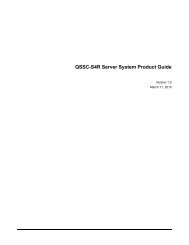Intel® Server System Server System "Emerald Ridge ... - CTL
Intel® Server System Server System "Emerald Ridge ... - CTL
Intel® Server System Server System "Emerald Ridge ... - CTL
Create successful ePaper yourself
Turn your PDF publications into a flip-book with our unique Google optimized e-Paper software.
錯 誤 ! 尚 未 定 義 樣 式 。 EPSFunctional SpecificationA fan failure, or removal of hot-swap fans up to the number of redundant fans specified in theSDR, in a fan configuration is a degraded failure and is reflected in the front panel status assuch. A fan failure or removal that exceeds the number of redundant fans is a fatal insufficientresources condition and is reflected in the front panel status as a fatal error.Redundancy is checked only when the system is in the DC-on state. Fan redundancy changesthat occur when the system is DC-off, or when AC is removed will not be logged until the systemis turned-on.See the Chassis Management section for chassis specific fan redundancy configuration.3.16.3 Fan Domains<strong>System</strong> fan speeds are controlled through pulse width modulation (PWM) signals, which aredriven separately for each domain by integrated PWM hardware. Fan speed is changed byadjusting the duty-cycle, which is the percentage of time the signal is driven high in each pulse.The BMC controls the average duty-cycle of each PWM signal through direct manipulation ofthe integrated PWM control registers.See the Chassis Management section for fan mapping information.3.16.4 Nominal Fan SpeedA fan domain’s nominal fan speed can be configured as static (fixed value) or controlled by thestate of one or more associated temperature sensors.OEM SDR records are used to configure which temperature sensors are associated with whichfan control domains and the algorithmic relationship between the temperature and fan speed.Multiple OEM SDRs can reference or control the same fan control domain, and multiple OEMSDRs can reference the same temperature sensors.The PWM duty-cycle value for a domain is computed as a percentage using one or moreinstances of a stepwise linear algorithm and a clamp algorithm. The transition from onecomputed nominal fan speed (PWM value) to another is ramped over time to minimize audibletransitions. The ramp rate is configurable via the OEM SDR.Multiple stepwise linear and clamp controls can be defined for each fan domain and usedsimultaneously. For each domain, the BMC uses the maximum of the domain’s stepwise linearcontrol contributions and the sum of the domain’s clamp control contributions to compute thedomain’s PWM value, except that a stepwise linear instance can be configured to provide thedomain maximum.Hysteresis can be specified to minimize fan speed oscillation and to smooth fan speedtransitions. If a Tcontrol SDR record does not contain a hysteresis definition, e.g. an SDRadhering to a legacy format, the BMC will assume a hysteresis value of zero.3.16.4.1 Stepwise Linear3.16.4.1.1 Fan Speed ContributionEach stepwise linear Tcontrol sub-record defines a lookup table that maps temperature sensorreadings to fan speeds. The table entries must be in increasing order of temperature. The BMCRevision 1.1Intel ® Confidential 29









